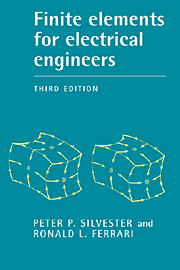Book contents
- Frontmatter
- Contents
- Preface to the third edition
- Preface to the first edition
- 1 Finite elements in one dimension
- 2 First-order triangular elements for potential problems
- 3 Electromagnetics of finite elements
- 4 Simplex elements for the scalar Helmholtz equation
- 5 Differential operators in ferromagnetic materials
- 6 Finite elements for integral operators
- 7 Curvilinear, vectorial and unbounded elements
- 8 Time and frequency domain problems in bounded systems
- 9 Unbounded radiation and scattering
- 10 Numerical solution of finite element equations
- Appendix 1 Calculations on simplex elements
- Appendix 2 Integration by parts, Green's theorems and Green's functions
- Appendix 3 Simplex element tables
- Appendix 4 Utility programs and style notes
- Appendix 5 Laboratory problems and exercises
- Index
9 - Unbounded radiation and scattering
Published online by Cambridge University Press: 05 June 2012
- Frontmatter
- Contents
- Preface to the third edition
- Preface to the first edition
- 1 Finite elements in one dimension
- 2 First-order triangular elements for potential problems
- 3 Electromagnetics of finite elements
- 4 Simplex elements for the scalar Helmholtz equation
- 5 Differential operators in ferromagnetic materials
- 6 Finite elements for integral operators
- 7 Curvilinear, vectorial and unbounded elements
- 8 Time and frequency domain problems in bounded systems
- 9 Unbounded radiation and scattering
- 10 Numerical solution of finite element equations
- Appendix 1 Calculations on simplex elements
- Appendix 2 Integration by parts, Green's theorems and Green's functions
- Appendix 3 Simplex element tables
- Appendix 4 Utility programs and style notes
- Appendix 5 Laboratory problems and exercises
- Index
Summary
Introduction
Radiation and scattering of high-frequency electromagnetic energy arises in many important physical circumstances, particularly those relating to communications and radar systems. The need to design and improve such systems has given rise to much complex and sophisticated numerical analysis, mostly tailored to suit particular geometries. Integral methods have been used extensively and may be applied quite effectively to obtain numerical results for geometries involving just highly conducting elements, since for such cases the appropriate Green's functions are readily available and only the conducting surfaces need be discretized. Dense but relatively small matrices turn up in the resulting linear algebra; the techniques used are often described as ‘moment methods’, see Chapter 6. Purely integral techniques can be extended to situations with the presence of uniform dielectric or magnetic materials, whereas the dense matrices generated tend to become large and the procedures unwieldy. The differential-operator finite element approaches to the solution of high-frequency electromagnetic problems are well suited to cases where there is inhomogeneous material present, resulting in relatively large but sparse and banded matrices, easily handled by standard linear algebra routines. However invariably problems involve an inhomogeneous region which is limited in extent, bordered by free space constituting an external region which reaches to infinity. It is thus a logical further step to develop hybrid finite element methods, incorporating discretized boundary operations dealing with the uniform external region, for solving general radiation and scattering problems.
- Type
- Chapter
- Information
- Finite Elements for Electrical Engineers , pp. 404 - 429Publisher: Cambridge University PressPrint publication year: 1996

